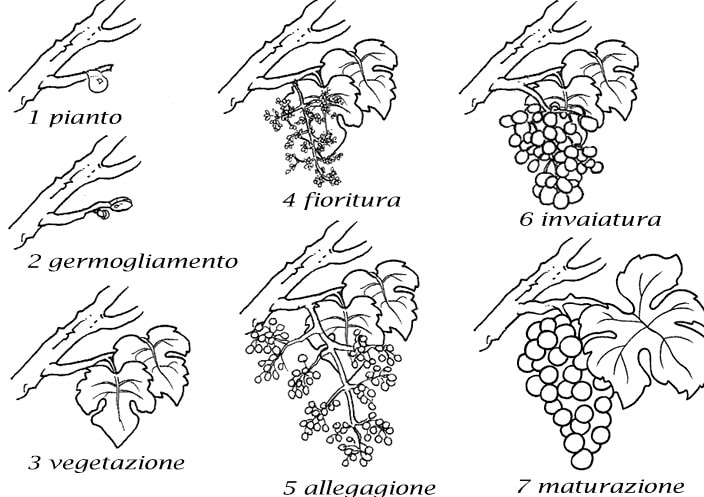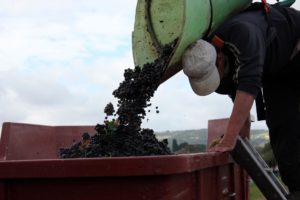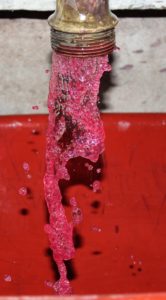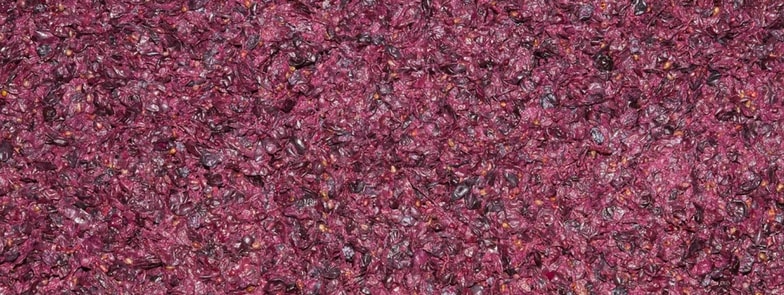The must.
it is an article by La Fillossera – lafillossera.com
The must is the juice obtained by pressing the grapes.
There are hundreds of substances that can be found inside the must, following the main ones:
Water 70-80%
Sugars 17-23%
Organic acids 0.7-1.1%
Tartaric acid 0.3-0.7%
Malic acid 0.2-0.6%
Citric acid and others 0.01-0.03%
Mineral substances 0.1-0.2%
Nitrogenous substances 0.05-0.1%
Pectic, polyphenol, anthocyanins, flavorings and precursors 0.02-0.03%
Water is the base of the must in which all other substances are dispersed. Sugar is the element that will determine the amount of ethyl alcohol in wine. Of course, much higher the must’s sugar degree will be, much higher the wine’s ethyl alcohol will be. Knowing the percentage of sugar in the must you can calculate the alcoholic strength of wine using the following formula:
% By weight of sugars in must * 0,6 (conversion factor) =% by volume of ethyl alcohol into wine
The acidity of the must is mainly related to the fixed acidity that in the wine gives that pleasant feeling of freshness. From the previous list, it is possible to observe the presence of so-called volatile acids (acetic acid) which together with the fixed ones constitute total acidity.
Polyphenols, in different shapes, along with winemaking techniques, are key to defining the personality of wine in terms of color, structure, tannicity and longevity.
The odorous substances found mainly in the skin, such as terpenes, aroma precursors and sulfur compounds, impress the aromatic characteristics of the wine. During fermentation, these elements are able to dislodge themselves from sugar molecules by releasing their aromatic kit. The main ones are related to a group of alcohols, terpenes, which are partially free and partially glycosylated. This transformation takes place through the yeast enzymes that break the glycosylated aroma into sugar and the volatile aroma which becomes perceptible by the smell.
Pectic substances, present in small quantities in small quantities, in the various forms such as pectin, gums, muclavinos and pentosans have the peculiarity of giving the wine the softness. A very useful example to understand the effects of these substances on the final product are wines obtained from grapes favored by the noble mold that exhibit a higher concentration of pectic substances that make the wines particularly soft.
Minerals and especially vitamins are the “fuel” of the yeasts and allow the latter to develop and carry out fermentative processes. The most important vitamin and B1 that has an accelerating function for alcoholic fermentation and avoids the formation of substances that can bind to sulfur dioxide. Nitrogenous substances inorganic (eg ammonium salts) favor the work of yeasts while those in organic form can cause turbidity in wine. The enzymes present in the must increase the rate of chemical reactions.
In addition to substances that favor fermentation in the must, many “indigenous” substances can be found which can result in incorrect fermentation and therefore variable quality products. Some of these are polyphenoloxidase and laccase, which are found mainly in grapes clashed by fungal parasites and which cause the oxidation of certain substances with possible oatmeal and loss of aromatic freshness. Proteases also have negative effects because they cause protein breakage, releasing amino acids and peptides that are easily assimilated by yeasts.
Corrections of the must
Corrections are mainly done to change the composition of the must that is not always optimal. Their main goal is to vary the sugar concentration and acidity as needed.
Increasing the sugar level
To increase the amount of sugar in the must you can use different methods:
Cutting with sugar-rich musts: almost in disuse.
Addition of rectified concentrated must: concentrated must is obtained by evaporating a certain amount of vacuum water to avoid sugar caramelization and alteration of organoleptic characteristics. In quality production, only rectified concentrated grape must (MCR) is used, which, as previously mentioned, undergoes a subsequent rectification by obtaining a solution of water and grape sugar with sensory profiles that remain unaltered.
Sugar Addition: Sugar addition is not allowed in Italy, apart from liqueur wines, while in some areas of northern Europe may be used.
Adding mild wort or sweet filtered: obtained respectively by adding a high amount of sulfur dioxide to block fermentation and centrifuging and filtration of a partially fermented must with a sugar content of 18-20%.
Increase in acidity
The increase of the acidity of the must is made by the addition of tartaric acid. The acidity level is very important because, during the fermentation, the acids are transformed and this can cause a decrease in the vivacity of the color and taste perception of freshness. Acidity also protects the must from bacterial and fungal diseases.
Decreasing acidity
This activity is very rare and is carried out by adding salts such as calcium carbonate, neutral tartrate, and potassium bicarbonate. This practice is desirable for musts obtained from grapes produced in cold vintages and therefore have not reached a perfect maturation state.
Osmosis and reverse osmosis
These methods, very expensive, are applied to reduce or increase the substances (sugars and acids) without altering the sensory characteristics of the must. The principle on which it is based is the use of a semi-transparent diaphragm which has the property of passing, in the case of osmosis, a portion of less concentrated liquid to the more concentrated liquid and, in the case of reverse osmosis, a portion of liquid With greater concentrations towards the liquid with a lower concentration. In the first case, less concentrated musts are obtained and in the second case concentrates more concentrated.
Concentrators with cold vacuum evaporator
This method has been spreading in recent years due to the quality of the final product with a remarkable increase in extractive substances. In addition, the equipment used has a minimum footprint and is very easy to use. The machining mode is to deprive the solid part of the solid part and send it to a small reservoir within which a push depression is created that evaporates pure water at a temperature of 22 to 24 ° C.
Must treatments
The must before going to the winemaking stage is subjected to various treatments aimed at promoting fermentation, enhancing its characteristics and avoiding unpleasant effects due to bacteria or molds. Below we will look at the different treatments:
Clarification
Is made by clarifying substances such as gelatin or bentonite, casein or silica gel and then with centrifugation or delicate filtration. These activities allow the clarification of the must, also favored by the cooling that allows solid parts to fall on the bottom of the tanks. Refrigeration is achieved with insulated tanks, double wall, inside which a refrigerant is circulated.
Decanting
A treatment that is performed to clarify the must without adding of clarifiers. The treatment is done by cooling the must at temperatures from 6 to 10 ° C to reduce the solubility of the solid particles and thus promote precipitation. This treatment can be done using pectolytic enzymes that allow for more precise precipitation without the aid of clarifying substances that may alter the sensory characteristics of the must.
Addition of sulfur dioxide
Is the most widely used treatment and consists in the addition of potassium metabisulphide must. The amount of sulfur dioxide that is used depends on the bacterial charge and the effects that you want to obtain; Thanks to the antioxidant properties, it limits the damage caused by oxygen and oxidative enzymes by reducing the diurnal phenomena; Favors clarification; Inhibits the development of wild bacteria and yeasts by favoring elliptical and selected yeasts and promotes the solubilization of polyphenolic substances present in the skin.
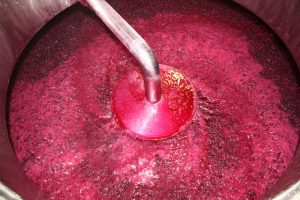
Types of must
The must can be subjected to further treatments which give rise to various products used in the wine sector.
Must of partially fermented grapes
It is obtained by partial fermentation of grape must and having actual TAV greater than 1% in volume and less than three-fifths of its total TAV (the one which has reached the total transformation of sugars into alcohol).
Concentrated grape must
Concentrated grape must is obtained by partial dehydration using physical means excluding direct fire (which would produce sugar candy) so that the value indicated by the refractometer at 20 ° C is not less than 50.9%. The most used means to reduce the percentage of water and to obtain concentration are vacuum evaporation, refrigeration with the subsequent removal of water as ice. The grape must used must have a minimum natural TAV set for the wine-growing area and belong to specific cultivars. Its effective TAV must be equal to or greater than 1% vol.
Rectified concentrated grape must (ZUI)
The rectified concentrated grape must (ZUI) is the non-caramelized liquid product obtained by partial dehydration of grape must. Performed by any authorized method, excluding direct fire, so that the value indicated by the refractometer at a temperature of 20 ° C, used according to a method to be established, is not less than 61,7%. Adjusted concentrated must is to be considered a private product of all those natural substances, other than sugar and water, which could make organoleptic changes to the must to which it is added. Its use makes it possible not to apply both must and wine to further correction procedures, guaranteeing wines of a certain quality.
Mute must
The mute must is a must to which sulfur dioxide has been added in order to stop its fermentation. It is said to be “silent” because of the absence of the typical gurgling of the fermentative process.
Cooked must
Parsley caramelised fruit obtained by the elimination of water from must or mussel by direct heating to normal atmospheric pressure. The resulting sugar concentration is subject to measurements with a Babo or Baumé density meter, which is calibrated at a well-defined reading temperature. If the reading temperature deviates from the calibration value, a correction coefficient must be entered.
Sweet filtered. Partly partially fermented, whose further fermentation has been obstructed by filtration or centrifugation, and with the aid of other treatments and practices permitted.
“Mistella” or “sifone”
Product obtained from a must with total natural alcohol of not less than 12 °, rendered not-fermentable by the addition of wine spirits or spirits in quantities such as to produce the alcoholic strength of alcohol (actual alcoholic strength by volume) between 16% and 20% % Vol.
+ news by La Fillossera


